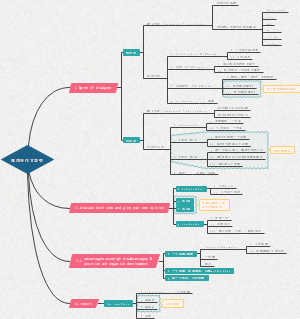导图社区 新编英语语法教程第16课
- 154
- 3
- 0
- 举报
新编英语语法教程第16课
新编英语语法教程第16课的思维导图,被动意义表示法,介绍了语态概说、主动句与被动句、被动结构和被动意义的知识。
编辑于2023-05-14 15:24:48 福建省- 相似推荐
- 大纲
被动意义表示法
语态概说
主动态和别动态
GET-型被动态:get(助动词)+-ed分词 常用口语表达,强调动作。如一些未料到会发生的突发性事件,用于 in the end ...(最终,结果),eventually...(最后,终于),at last...(最终)等连接状语后面表某种结局。In the end he got invited.
词组动词的被动态 视为及物动词 其后副词小品词和介词不可省略
动词+介词:look after、talk about :this matter is bening looked into.
动词+副词小品词:set up、bring about :when was the hospital set up.
动词+副词小品词+介词:do away with、face up to :such a state thing cannot be put up with.
非限定动词的被动态
a、不定式的被动态:i am proud to be thus chosen.
b、-ing分词的被动态:i object to being kept waiting.
以上两点 均可作动词宾语 意义有时不同 He forgot to be photographed.=he fogot that he had to be photographed. (他忘记要照相了) He fogot being photographed. =he forgot that he had been photographed.(他忘记他已经照过相了)
主动句与被动句
主动句转被动句的转化规则
1、 主动句为SVO结构,将主动句宾语变成被动句的主语,将随后的主动态动词词组变成被动态的词组,将原本主语放在随后的by-词组中,如果不突出动作执行者,可省去by-词组。 :They published the criminal. = The criminal was published.
2、主动句带有情态助动词或半助动词,变成被动句时,情态助动词或者半助动词褒词不变,随后不定式由主动态变成被动态。 He is likely to let you down =you are likely to be let down. They should do the work at once. =the work should be done at once
3、当SCVoO结构变成被动句时,Father gave me(间) a watch(直). a 以间接宾语为被动句主语。I was given a watch. b 以直接宾语为被动句主语。 A watch was given to me.(当间接宾语作为保留宾语后置时,其前必须带介词) 当一个宾语变成被动句的主语时,另一个宾语变成了“保留宾语”
4、结构为SVOC,将原本宾语变成主语,动词主动态变成被动态,原本的宾语宾语补语变成主语补语 We have painted the window white =The window have been printed white
5、by-词组的运用取决句子是否要突出动作执行者 The picture was printed by (a very good friend of mine who i like you to meet somtimes)主语过长,避免头重脚轻
6、并非所以主动句和被动句都可以转化 : aown 和have 都可以表所有关系但是own 可以在被动句里表现但 have不可以。the house was had by Bob.错误 b一些类似have(有)的静态动词也没有被动态 比如 become(适合)hold (能容纳)resemble(像);一些主动句的宾语为反身代词或相互代词的时候也没有被动态 c少数动词只以被动态出现 was born ;is reputed
两种被动句型
People believe that he is ill. It is believed that he is ill.(I) He is believed to be ill.(II)
将句型I 转化成句型II,句型 II的不定式结构取决于句型I的that-分句的动词形式。
1、当that-分句谓语动词为表示将来时间的will-结构或者现在进行体时to be +-ing He is thought to be coming 特殊情况:句型I主句主动词 except ,句型II的不定式结构通常用to do : it is except that he will come .= he is except to come.
2、当that-分句的谓语动词为表示现在时间的一般现在时间 to do it is thought that he drives badly = he is thought to drive badly 如果that-分句谓语为表现现在时间段的现在进行体,句型II的不定式结构用进行体的形式 :it is believed that he is working hard=he is believed to be working hard
3、当that-分句谓语动词为过去时间的一般过去时和现在完成体 to have +-ed he is believed to have come that -分句谓语动词为过去进行体,句型II用完成进行体 to have been+-ed或者 to have been +-ed互换
两种句型能否转换取决于句型I的主动词 :assume,believe,except ,fear,feel,know,presume,report,think,understand表“估计”“相信”的词。 口语中suppose也可归于,但be suppose to 作为半助动词,表“应该”不适用该规则。
被动句使用场合
说话人为了把句子的重心放在事情本身而不必提到施动者时
由于不知道事件的施动者为谁,含蓄不愿意道出施动者为谁
强调施动者,常用by-词组
上下文语境避免中途换主语
被动结构和被动意义
英汉被动意义表达法比较
主动结构表被动意义
his novel don't sell(他的小时销路不佳) 外在因素影响 his novel are not sold(他的小说卖不出去) 内在特征
被动结构还是系补结构
并不是所有 助动词be+及物动词的-ed分词就是被动态 -ed分词可以当形容词 当它们与主动词be 连用构成所谓的“系补结构”即-ed分词作主语补语。
i am annoyed with him系补. i was annoyed by mosquitoes all night.被动









